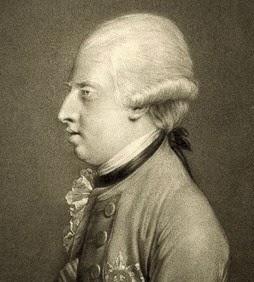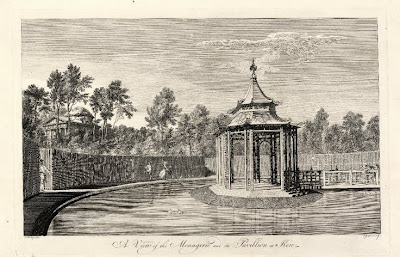 |
| William Henry, Duke of Gloucester by Richard Earlom after Hugh Douglas Hamilton pubd by Robert Sayer (1771) © British Museum |
Prince William Henry, 1st Duke of Gloucester (14 November 1743 - 25 August 1805), was one of the younger brothers of George III. He was a regular visitor to Weymouth and he lent his house there to his brother George for his seaside breaks.
Family background
Prince William Henry was born on 14 November 1743 at Leicester House, London, the third son of Frederick, Prince of Wales, and his wife Augusta of Saxe-Gotha.
William’s father, Frederick, did not get on well with his parents, George II and Queen Caroline, and his behaviour on the birth of his first child, Augusta, in 1737 resulted in him being banned from his father’s Court.
As a result, William lived mostly at Kew, in Kew House (also known as the White House), where his father accumulated a menagerie of exotic animals and pursued a passion for botany which he shared with his wife. Frederick taught his family astronomy and encouraged a variety of entertainments including rowing, cricket, outings to fairs and play acting.
 |
| A view of the menagerie and its pavilion at Kew Print by C Grignion after T Sandby pubd by Sir William Chambers (1763) © British Museum |
Titles
William was made a Knight of the Garter at Windsor in 1762 and Duke of Gloucester and Edinburgh and Earl of Connaught in Ireland on 19 November 1764 (1).
He was made Ranger of Hampton Court Park, Ranger and Keeper of Cranborne Chase in Windsor Forest and Lord Warden and Keeper of the New Forest. He became Chancellor of the University of Dublin in 1771.
A secret marriage
In 1764, William started courting Maria, the Countess Dowager Waldegrave. Maria was the illegitimate daughter of Sir Edward Walpole and the widow of 2nd Earl Waldegrave. On 6 September 1766, they were married secretly, without witnesses, at the Duke’s house in Pall Mall by Maria’s chaplain, Dr Morton.
George III did not believe the rumours that William had actually married Maria and sent his brother abroad to visit other European royal families as a diplomatic envoy for the British monarchy in an attempt to extricate him from his entanglement with Maria, whom he felt was a bad influence on him.
 |
| Maria Waldegrave, later Duchess of Gloucester from Letters of Horace Walpole to Sir Horace Mann Vol 4 (1844) |
When Maria became pregnant, William wrote to the King to acknowledge his marriage. An enquiry into the validity of the marriage was held by the Privy Council on 23 May 1773, just days before the birth of a daughter, Sophia Matilda. The King was forced to admit the legality of the marriage and the child was given the title of Princess.
But the King was deeply hurt by his favourite brother’s deception. Whilst William had been ranting about the Duke of Cumberland’s shameful marriage to Lady Ann Horton the previous year, he had all the time been married to a commoner himself. The Duke and Duchess and their children were banned from the Court and William’s diplomatic missions came to an end. For the sake of economy and William’s health, they went to live on the continent.
The family complaint?
In 1771, William became very unwell with a similar illness to that from which his brother George later suffered. He endured a further bout a few years later and an even more serious episode whilst returning to England in 1777.
Reconciliation
The King’s concern over William’s health softened his attitude towards his brother, but he refused his request to be allowed to take an active military role in the American war.
Eager to serve his country, William managed to acquire a copy of the French plans for invading England which he sent to George, but it was not until the Gordon Riots of 1780 when he helped to restore peace as Colonel of the 1st regiment of foot guards, that he earned the King’s gratitude and was once more received by his brother.
Weymouth
William had a long and happy association with Weymouth which began, by accident, on Saturday 24 August 1771, when he first visited the town:
“The Duke of Gloucester, being detained by contrary winds, came from aboard the Venus, dined and drank tea at the Rooms at Weymouth, and afterwards returned on board.”(2)
 |
| The Old Rooms, Weymouth |
 |
| Gloucester Lodge on Weymouth seafront |
William continued to visit Weymouth. In 1790, he visited with his brother, the Duke of Cumberland, and in 1794, he was there with the King’s party, accompanied by his daughter.
A problematic marriage
William and Maria had three children: Sophia Matilda (1773), Caroline Augusta Maria (1774) who died as a baby and William Frederick (1776).
Over time, their relationship soured. William had an affair with Lady Almeria Carpenter, Maria’s lady in waiting, by whom he had an illegitimate daughter, Louisa Maria La Coast in 1782. For the majority of the period from 1784 to 1787, William and Maria lived in Geneva and Italy, with Lady Almeria still part of their household.
 |
| Lady Almeria Carpenter from Macdonald of the Isles by AM Stirling (1913) |
Family relationships
William was of a quiet, retiring disposition and managed to maintain good relationships with his nephews. He tried unsuccessfully to effect a reconciliation between George, Prince of Wales, and his wife Caroline in 1796.
Death of the Duke of Gloucester
William’s health deteriorated and he died on 25 August 1805 at his home, Gloucester House, Upper Grosvenor Street, London. By his own desire, he was buried privately at St George’s Chapel, Windsor, on 4 September.
The King was in Weymouth when he received news of his brother’s death and the town went into a week of mourning for “their first patron and benefactor and as the sole means of introducing his royal brother here”(3).
Notes
(1) The date is given as 19 November in the Oxford Dictionary of National Biography but 17 November in Debrett’s.
(2) From The Gentleman’s Magazine (Aug 1771).
(3) From Weymouth, an illustrated history (1983).
Sources used include:
Boddy, Maureen and West, Jack, Weymouth, an illustrated history (The Dovecote Press, 1983, Wimborne)
Delamotte, Peter, The Weymouth Guide (1785, Weymouth)
Groom, Susanne and Prosser, Lee, Kew Palace, the official illustrated history (2006)
Hibbert, Christopher, George III (1998, Viking, Great Britain)
Kilburn, Matthew, William Henry, Prince, first Duke of Gloucester and Edinburgh (1743-1805) Oxford Dictionary of National Biography (Oxford University Press, 2004; online edn Jan 2008, accessed 28 Oct 2013)
The Gentleman's Magazine and Historical Chronicle (1771)
Walpole, Horace, Letters of Horace Walpole to Sir Horace Mann in 4 volumes (1844)
Photographs by Andrew Knowles - www.flickr.com/photos/dragontomato

Louisa Maria La Coast is my 4th great grandmother much to my surprise
ReplyDelete